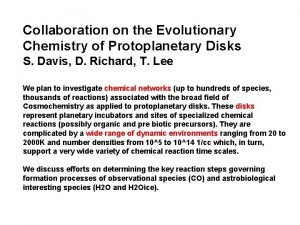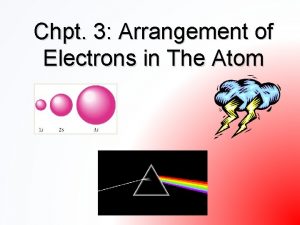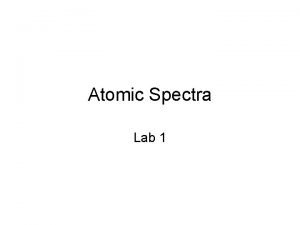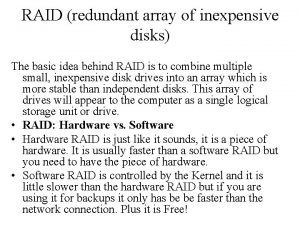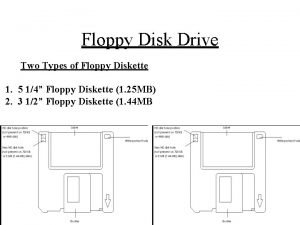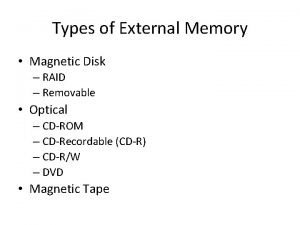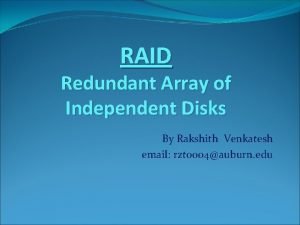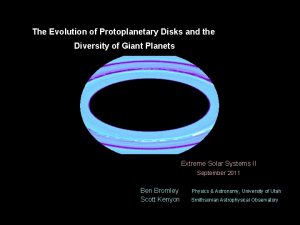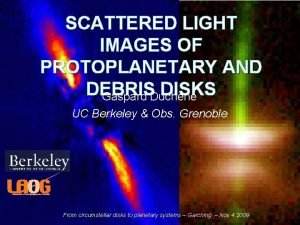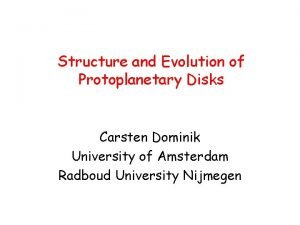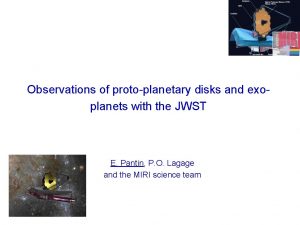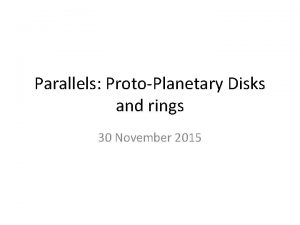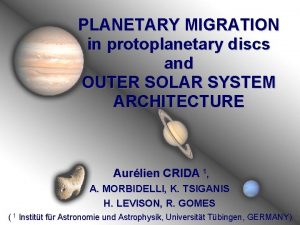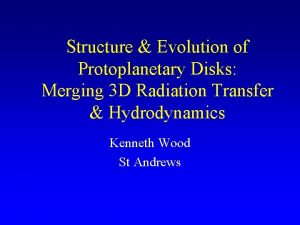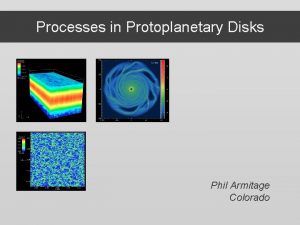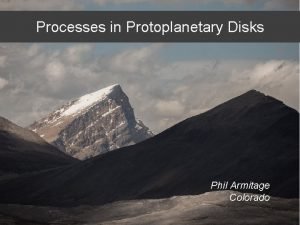Chemistry and line emission of outer protoplanetary disks













- Slides: 13

Chemistry and line emission of outer protoplanetary disks Inga Kamp • Introduction to protoplanetary disks and their modeling • Chemistry in the outer disks: - the influence of the central star, PAHs, and X-rays on the disk - Deuterium Chemistry • Pushing the limits of future observing facilities Collaborators: Kees Dullemond, Jesus Emilio Enriquez, Bastiaan Jonkheid, Ewine van Dishoeck, Michiel Hogerheijde, et al.

Why are the outer disks important?

Models of Protoplanetary Disks A quiet protoplanetary disk: - stationary 2 D disk models - irradiation by the star (+ accretion) determines the disk structure [Chiang & Goldreich 1997, Willacy & Langer 2000, Aikawa et al 2002, Jonkheid et al. 2004, Kamp & Dullemond 2004] A more dynamical picture of a protoplanetary accretion disk: - matter is mixed and transportet by turbulence - matter accretes onto the central star d. M/dt~10 -7 M Sun/yr Infalling gas and dust Protoplanet IR radiation Protostar Chemically active zone Visible and UV radiation Acc - matter continuously V~100 km/s falls in from the envelope causing an accretion shock at the disk surface [Aikawa et al. 1999, Gail 2001, Ilgner et al. 2004] Transport of matter and angular momentum reti on sho ck V~10 km/s Posters: Semenov et al. I. 63 Willacy et al. III. 73

Free parameters: • Stellar properties, L*, R*, M* • Dust properties, opacities, sizes • Elemental abundances • Disk dimensions, Ri, Ro • Surface density (disk mass) • turbulence/diffusion constants

The Chemical Network Example: CO formation and destruction C + OH CO + H CO + n C + O kijk~ 10 -10 … 10 -9 s-1 cm-3 ij ~ 10 -10 … 10 -8 s-1 - S(T)pa 2 ngvini + nini e (-E(ads)/k. T) • stationary solution with modified Newton-Raphson algorithm • time dependent solution using the Backward Differentiation Formula (BDF) e. g. VODE [ Hindmarsh 1980 ] • artificial neural networks [Asensio Ramos et al. 2005] [ Wedemeyer-Böhm, Kamp, Freytag, Bruls 2004]

What do we know about disk chemistry? The disks are layered: [Aikawa & Herbst 1999, Willacy & Langer 2000, van Zadelhoff et al. 2003, Semenov et al. 2004] surface layer --> photochemistry intermediate layer --> neutral & ion molecule gas chemistry disk midplane --> gas-grain chemistry

• The surface layers can get very hot (UV irradiation) • Gas and dust temperatures are not coupled in the surface layers • Photoelectric heating on PAHs set the gas temperature in the surface layer [Jonkheid et al. 2004, Kamp & Dullemond 2004, Nomura & Millar 2005] no PAHs Poster: Geers et al. I. 27

• Chemical destruction of H 2: H 2 + O --> H + OH • C/CO transition at lower/same optical depth as H/H 2 transition • Higher UV fluxes lead to lower molecule abundances in the disk atmosphere • Very confined OH layer in all T Tauri and Herbig models log n(H 2)/n(H) log n(CO)/ntot log n(OH)/ntot log n(HCO+)/ntot [Kamp et al. 2004, Nomura & Millar 2005] H/H 2

X-rays affect the chemistry and the disk temperature: R=700 AU, Z=220 AU • X-rays enhance the ionization fraction of the disk surface • Some molecules have higher abundances due to efficient ion-molecule chemistry (HCN) • X-rays can efficiently heat the disk in the absence of strong UV irradiation no X-rays [Aikawa & Herbst 1999, Kamp et al. 2005] Poster: Aikawa & Nomura III 02 Tgas in a 0. 01 M disk around an M star AU Mic no X-rays

Deuterium chemistry: • H 3+ is formed by cosmic rays throughout the disk H 3+ + HD --> H 2 D+ + HD --> HD 2+ + H 2 HD 2+ + HD --> D 3+ + H 2 (UV and X-rays do not penetrate that deep) • D/H in molecules is higher than the elemental D/H ratio in the ISM • Destruction via grain surface recombination and reactions with CO, N 2 [Aikawa & Herbst 1999, 2001, Ceccarelli & Dominik 2005] Posters: Ceccarelli et al. III. 13 Ceccarelli & Dominik III. 14

T Tauri star 0. 01 M OH layer above the disk photosphere: chromosphere log n(OH)/ntot hot [OI] 6300 Å OH + n O* + H O* is in the 1 D excited level; it decays to the ground state by emitting a 6300 Å photon gas + collisional excitation for Tgas > 3000 K OI 6300 Å emission in Orions proplyds is restricted to the skin of the disk d. M/dt = 10 -9 M /yr log n(OH)/ntot hot gas [Bally et al. 2000, Störzer & Hollenbach 1998; Orion proplyds] [Acke et al. 2005 (Herbig stars)]

Pushing the limits of future observations The mass of small dust grains decreases with stellar age (ISO, Spitzer) [Habing et al. (1999), Meyer et al. (2000), Habing et al. (2001), Spangler et al. 2001] Optically thin models (late stages of Herbig Ae star) 1. 5 x 10 -4 - 1. 5 x 10 -7 M How and when does the gas disappear from the disks? • Boundary conditions for planet formation • How many failed planetary systems are out there ? J=4 -3 J=3 -2 J=2 -1 ALMA detection limit J=1 -0 CO rotational lines

Conclusions: • Need for self-consistent disk models: disk structure + gas chemistry Posters: Semenov et al. I. 62, Jonkheid et al. III. 35, Nomura et al. III. 51 • Proper inclusion of ALL radiation sources: stellar UV, X-rays and external • Chemistry of the outer protoplanetary disks is driven by irradiation --> Importance of photochemistry • Future instrumentation will allow the detection of transition disks down to 0. 5 MEarth of gas Outlook: • Photochemistry, X-ray chemistry, three-body reactions • Gas-grain chemistry: desorption processes, molecule reactions on grains • next generation models: 2 D hydrodynamical disks with a realistic energy equation (gas temperature), radiative transfer, and full chemistry (gas, gas-grain and grain surface)
 Protoplanetary disk
Protoplanetary disk Absorption vs emission
Absorption vs emission Emission line spectra
Emission line spectra Emission line
Emission line A mechanism that spins reads and writes disks
A mechanism that spins reads and writes disks Disks and tapes can be stored ------- a library. eng101
Disks and tapes can be stored ------- a library. eng101 Tower of hanoi 4 disks
Tower of hanoi 4 disks Redundant array of inexpensive disks
Redundant array of inexpensive disks Types of floppy disks
Types of floppy disks Daisy wheel printer
Daisy wheel printer Types of magnetic disks
Types of magnetic disks Redundancy array of independent disk
Redundancy array of independent disk Disks of polycarbonate plastic from a supplier are analyzed
Disks of polycarbonate plastic from a supplier are analyzed Duffy's mvp levels
Duffy's mvp levels
